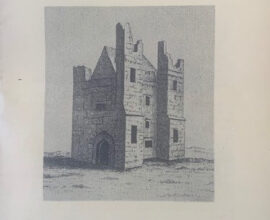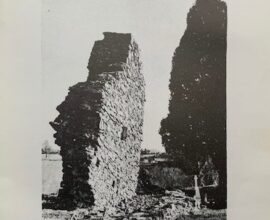Ardee Mills
The Mills at Ardee in 1304
Mills were a familiar sight in medieval Ireland. In the feudalised parts of the lordship every manor of any size had at least one, to which the tenants had to bring their produce if they wished to mill it (an obligation which was known as ‘suit to mill’. The mill was thus not only an essential element in the economy of any manor but was also a source of considerable profit to the lord who owned it. For that reason lords were careful to see that there was no erosion of their milling rights. If tenants had fallen away, perhaps because the mill had been allowed to become unworkable, then they must be made to return to the mill once it was in operation.
Thus, at Ardee in 1303, when carpenters contracted to repair the three mills and mill houses, they were responsible until the mills were once more producing tolls paid by tenants for grinding. The rebuilding of the mills meant that the tenants had to ‘made suit’ as formerly they were accustomed and held to make.
A case heard before the justicar in Cork in 1307 illustrates well how, when the mill began to decay, the tenants of the manor escaped from their obligation to use the mill until their lord built a new mill on the same stretch of water and compelled the tenants to come to it.
Profitability of Mills
From the lords point of view the mills were valuable property. Naturally the value of the mill depended on its state of repair, the efficiency of the miller and the quantities which passed through the mill. At New Ross in 1307 for example, there were five mills of which four were valued at only £13 6s 8d and one which was fallen and waste was of no value.
Another fact which could lower the value of mills was if they were dangerous to work. Accidents were frequent not only resulting in drownings in the mill race, but from mangling in the machinery – attempting to grease the cogs of the mill wheel while it was turning was especially dangerous.
If mills were valuable, it was because they had sufficient water to provide power. Water rights were therefore closely guarded and the defence of such rights frequently led to quarrels and litigation. A case before the justiciar in Dublin in 1306 demonstrates the lengths to which men would go in order to find a source of water power or to defend such a source. Thomas de Snyterby, who was chief justice of the bench, owned a mill in the city which seems to have had an inadequate water supply. His servant, Alan, ‘came many times by night’ to the mill of the abbey of St Thomas and opened the sluices to make the water come to the mill of Thomas his lord. But on one such occasion he was accosted by the abbeys miller, who tried to arrest him. Alan then struck the unfortunate miller on the head with a stone which he carried in a great glove so that he fell on the ground half dead and eventually ended up in court.
There are many cases where water rights were at the centre of litigation. In 1306 an inquiry into fishing rights on the river of Ardee revealed the existence of pools, weirs, sluices and other obstructions which may have helped millers but impeded the flow of salmon up the river, so that many were taken into the kings hands or removed.
Given the importance of mills, it is surprising that so little examination has been made of their function and operation into medieval Ireland. This is in no way due to lack of sources for a fair amount of information is scattered through the records of the medieval lordship
Obligations of the Repair of the Mill in Ardee
Memorandum that John Henuy, the receiver and the bailiffs of Ardee are ordered by the view of twelve good and faithful men, for whom they might be willing to answer, they cause the mills of Ardee to be repaired in the presence of Gilbert de Burton, assigned to supervise and keep a copy of the expenses and outlay on making the repairs of the said mills. And let it be allowed in the accounts etc. – Witness Richard of Barford 27 June 1303
Transcript of the indenture of the works of Ardee:
“Thursday after the feast of the Apostles Peter and Paul in the year 32 Edward I (2 July 1304) in the presence of Roger Gernon, sheriff of Uriel, the bailiffs of Ardee and twelve other faithful men, both of the vill and the barony, it was agreed between John Heruy and Gilbert de Burthen, clerk, on behalf of the king, on the one part and John of England, Walter the miller of Dundugyne, and Walter the miller of Ardee, carpenters on the other part, that the aforesaid John and Gilbert, by the view and counsel of the aforesaid sheriff bailiffs and twelve men gave and committed to the said John, Walter and Walter the repair and the making of the three kings mills at Ardee to be made anew.
The carpenters shall undertake all costs, their expenses and every charge both in the woods and elsewhere until they finish the three mills and the carpentry of the mill houses and bring them to multure. Save, however that the lord king will make the roofs of the said mills at his own cost and will find carriage for the timber for the mills. And to do this fully and faithfully, the said carpenters find William Bethe and Gilbert Marshal as their pledges.
Trinity term 1304
Roger Gernon sheriff of Uriel committed to prison, because he did not levy money of his service of Kilkenny and did not cause timber to be carried to the king at Ardee as ordered
Ardee: Commission of the mills there
Memorandum that the mills of Ardee, with the eels coming there are committed to Adam le Caumberleyng and John Coco for a term of twelve years at a rent of sixteen marks annually
Later account of the Oatmeal Milling, 1886
Among the few industries of Ardee a deserved prominence is given to that founded by William Munkittrick, which continues to be vigorously maintained by the enterprising firm of M Halpenny & Co. The steam mills built by Mr. Munkittrick favourably impress the stranger entering the town from the Dunleer direction. They occupy a very extensive area, fronting on William Street.
A solid structure of limestone, with brick window facings, five storeys high, contains a high pressure condensing steam engine and a considerable portion of the improved machinery relied on to maintain the high character of the “W M” and “Pinhead” brands of oatmeal in the English market. Buildings of lesser height cover a space of over three hundred feet. These are used for kilns, stores and offices. A small tributary to the Dee provides the water supply. Mr Munkittrick built the mills nearly fifty years agospecially for corn trade, and as a maltster, and well understood the merits of Louth oats. Indeed it may be said that the Ardee district claims superiourity over all others in the raising of oats and to this important fact was mainly due the enterprise of Mr Munkittrick.
In Liverpool and Manchester his brands found speedy recognition and the demand was such that it absorbed the entire production of his mills. Mr Munkittrick in 1860, a few years before his death, was succeeded in the milling trade by Mr Michael Halpenny. He was also a man of spirit, and having entered heartily into the enterprise, his methods soon succeeded in gaining liberal appreciation. He increased the manufacturing powers of the mills by the addition of new machinery and for several years enjoyed the profits of an excellent trade.
In 1881 he died and the mills have since been carried on with increased energy by his brothers, under the style of M Halpenny & Co. All the oats used are found in the local market and in the process of manufacture the greatest care is observed in the removal of small grains and impurities of all kinds in order to secure the eveness in quality which maintains an exaulted reputation. The oatmeal is packed in bags, or loads of 240lbs each and is shipped to England by the Dundalk and Newry Steam Packet Company, of which Peter Halpenny is a director.




